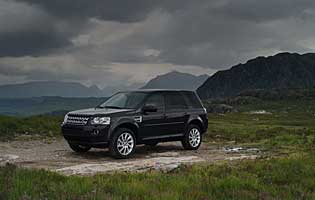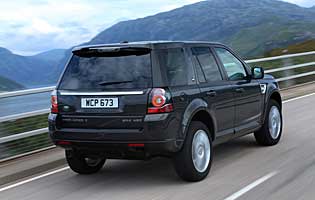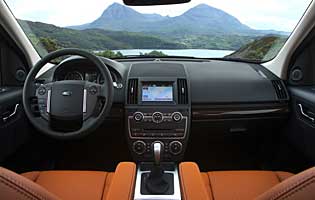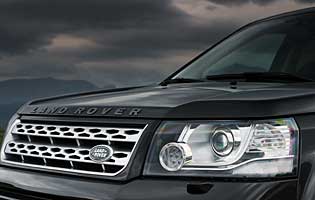



Overall rating
![]()
Handsome Freelander shape has aged well




![]()
All the fuss may have been around the latest Range Rover and the brand new Evoque but Land Rover has not forgotten its core products and so the capable and still-popular Freelander model has been refreshed for the latest model year. Detail changes both inside and out and some useful updates inherited from other models in the Land Rover range have also been included.
Recent years have seen a steady evolution of Land Rover's products. Now more overtly premium in their fit, finish, appearance and asking price, even the once modest Freelander's social standing has improved beyond all recognition. Thankfully this wasn't at the expense of on and off-road performance.
The '2' at the end of the Freelander's name has been around for some time and the car might look familiar, but the gently movement of the whole Land Rover range upwards in terms of quality and market position has culminated in a new dashboard on this latest version. The passing of time has also seen the Freelander 2 move closer to the bigger Discovery in terms of perceived and actual quality.
For all the leather upholstery and plush carpeting, capability remains at the heart of the Freelander's core values. The familiar engine range incorporates an eco-friendly stop-start system while the Terrain Response system now uses the Evoque's push button system which should keep the serious Land Rover enthusiasts happy. More crucially the better appointed cabin and wealth of options should appeal to people trading up from conventional compact premium cars.
The result is a car that still drives very well indeed and makes a strong case against some of the more default options in the class. The Freelander is considerably more competitive and feels closer to something from BMW or Mercedes in terms of cabin ambience, yet boasts enough street cred to see off the rapidly advancing competition.
It may only be a subtle update but the reality is that the Freelander 2 was already a strong contender and still a very capable car in its own right. The upgraded cabin is a significant improvement and helps to raise the quality feel of the car - although it is still below Range Rover standards - but the overall package is better than ever.
The significant boost in quality and standard equipment over the original model has meant a predictable rise in the Freelander's asking price. Choosing your optional extras carefully - few will greatly influence the car's residual value - and opting for the most frugal diesel variant will help matters. Quality improvements should see servicing as nothing more than routine.
Head, leg and elbowroom all round is good in the Freelander's cabin. There are also a useful number of storage areas in the cabin, especially the capacious box under the front armrest. At the rear, the back seats fold flat to further extend the load space and the tailgate opens high and wide for easy access, although it does require a hefty pull to close.
The cleaned-up dashboard is much easier to understand than before, and an improvement in the material quality is welcome too. The infotainment display screen sits high on the dashboard and shares its touchscreen facility and graphics with other models in the range. The rest of the controls are clearly labelled and require much less familiarisation than before.
For a car with the potential to throw you around on rough terrain, the Freelander's seats are pleasingly supportive - especially so if you ever decide to venture off-road. Back on the road, the only obvious noise is a small amount of wind and tyre noise. The diesel engines can clatter a little when cold, but this disappears once warmed up.
There's nothing particularly special about the Freelander's security provision but it does get the job done. Although the remote central locking plus the alarm and imobilisor package should prove more than adequate, a visible device such as a steering lock or even a tracking device if you plan on owning a high-spec variant would increase peace of mind and, in the case of the latter, could reduce your insurance premium.
All the major systems you'd expect in a premium car are present in the Freelander, such as traction and stability controls. Remember, these have also been tuned to provide assistance off road, along with the car's full-time all-wheel drive system. The Terrain Response facility could also be viewed as a safety device in extreme off-road conditions. Elsewhere, the cabin boasts seven airbags - including one for the driver's knee area.
4x4s are rarely famous for their on-road abilities as they are often developed as a compromise. Although the Freelander boasts a high ground clearance, it resists pitch and roll well when driven on road. Grip levels are high thanks to the car's intelligent permanent all-wheel drive system, and the inclusion of a cut-down version of the Discovery's Terrain Response control means different conditions (mud, gravel, sand etc) can be dialled in to improve off-road performance.
Despite not being directly comparable with a conventional people carrier, the Freelander works well as a family car. More of a spacious, high-rise hatch than MPV, the car boasts plenty of room for the average size family. The optional rear audio system will be a boon on long journeys, and the car's go-anywhere appeal with no doubt attract buyers with an active lifestyle.
The Freelander is an easy car to drive and its controls are light and visibility is good from the lofty driving position, making it ideal for a novice driver. However, it's not a cheap car to buy and run, while parking and manoeuvring the Freelander in tight spaces is likely to challenge an inexperienced driver.
Its latest products reflect a much improved performance in terms of quality; there's no question that what you can see and touch is better than before, And mechanical reliability is said to be more robust.
The Freelander is a little less car-orientated than some SUVs because it remains a 'proper' off-roader, which will mean more of a stretch for less able bodied occupants to access the cabin. The same is true when you get out - there's more of a pronounced step down than with certain rivals. At the rear, the car's high ground clearance pays off as the boot floor is near waist height, making loading and unloading heavy items easy.
The standard fit radio and CD player combination works well and the unit is placed high up for ease of use - the steering wheel controls are most welcome. Numerous options exist, include CD changers, better amplification, MP3 player integration, rear seat audio connections and a full-colour touch screen sat-nav. The latter is very impressive and is quick to respond to route changes but route programming could be more intuitive.
With the car's upmarket status being heavily promoted, darker hues suggest a more premium feel and will no doubt better assist the Freelander come trade in time. Inside, numerous trim combinations exist, and again it's the darker options that work the best, be they leather or fabric - that also goes for the fascia trim, as the light wood option isn't terribly attractive.
The Freelander might appear big by family car standards but it is no more difficult to park than your average hatchback. The lofty driving position helps, as does the light steering. The car's large side mirrors prove very useful. Predictably, parking sensors are also a big help.
Spare wheel is located at the rear underneath the car.
Engine range: 2.2-litre TD4 diesel (150bhp, 190bhp). Six-speed manual fitted as standard to 150bhp variant, six-speed auto fitted to 190bhp model - optional on lesser powered Freelander. Trim levels: S, GS, XS, HSE, Dynamic, HSE Lux.
Honda CR-V Smart, well built and refined but better suited to on-road duties
BMW X3 Not cheap but very capable and fuel efficient too
Hyundai Santa Fe Affordable alternative lacks Freelander's brand image
Volkswagen Tiguan Another upmarket Freelander alternative but clearly biased towards road use